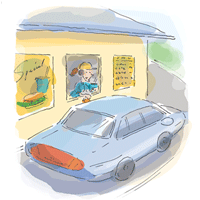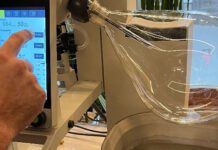Advanced drive-thru technology helps operators boost sales
hey may not be much to look at — a menu board and speaker box set among a few shrubs and some landscaping stone, plus a window or two on the back end — but drive-thrus are the backbone of the quick-service restaurant (QSR) industry. They seamlessly connect busy consumers with the food they need to fuel their day.
Drive-thru customers don’t step foot in the restaurant, unless it’s to complain about an order gone awry, but they still expect the same level of service and quality found in-house, to be delivered to their cars. In fact, drive-thrus account for upwards of 85 per cent of sales at some QSRs; investing in the latest technology will ensure this area of the business runs at optimal efficiency.
As a vendor for national, U.S. chains like Hardee’s, Carl’s Jr. and Arby’s, Pennsylvania-based Hyperactive Technologies has a mandate to stay on top of ever-evolving drive-thru technology. Frank Amoruso, Hyperactive’s president and COO, reiterates that since today’s drive-thrus often account for the majority of a QSR’s business, owners and operators need to get on board with the right technologies. “Smart chains are focusing on how to better their drive-thrus,” he says. “It’s not just about being fast but being accurate and serving the best quality food with a high quality of service.”
If you still have a crackly, hard-to-hear speaker box positioned at the start of your drive-thru line, it’s time to upgrade. Today, companies are outfitting employees with wireless headsets and making use of digital telecommunications capabilities to ensure clear interactions with customers from start to finish.
The preferred maximum time for a car to wait in the drive-thru line is just over three minutes, says Amoruso. To help operators achieve this standard, new car-tracking software is an accurate tool. The latest monitoring systems can track the time every car spends in the drive-thru line using colour coding and large digital timer read-outs, he says. They also link up with in-store point-of-sale systems, allowing managers to target specific menu items or times of day where service needs improvement.
“The more data you have the better management decisions you can make about processes,” says Amoruso. Other trends he’s pegged as becoming increasingly popular with franchisees are touch-screen kiosks, large outdoor LED menu display boards and 360-degree cameras instead of standard underground drive-thru loops to monitor cars in line.
Craig Milne, franchisee for Panera Bread’s three Canadian units, plans to open his first drive-thru next summer at the Richmond Hill, Ont., location. “We’ll set it up so that it’s really a second café to service our customers,” he said. “It may not necessarily have the displays, but it’s a full production line separate from the main line.”
Even though the target time is set at just three minutes per car, Milne says everything will be made-to-order and that new technologies, like wireless headsets, car-monitoring timers and well-trained employees, will help Panera reach that goal.
He estimates that building a drive-thru at a Panera location adds an additional 10 to 15 per cent to the cost of the unit, but he believes it’s worth it. “It’s not just about a transaction,” he says. “It’s about making the drive-thru a good, enjoyable and friendly experience.”
Illustration by Scot Ritchie





















